Wahid Bhimji
Discriminative versus Generative Approaches to Simulation-based Inference
Mar 11, 2025Abstract:Most of the fundamental, emergent, and phenomenological parameters of particle and nuclear physics are determined through parametric template fits. Simulations are used to populate histograms which are then matched to data. This approach is inherently lossy, since histograms are binned and low-dimensional. Deep learning has enabled unbinned and high-dimensional parameter estimation through neural likelihiood(-ratio) estimation. We compare two approaches for neural simulation-based inference (NSBI): one based on discriminative learning (classification) and one based on generative modeling. These two approaches are directly evaluated on the same datasets, with a similar level of hyperparameter optimization in both cases. In addition to a Gaussian dataset, we study NSBI using a Higgs boson dataset from the FAIR Universe Challenge. We find that both the direct likelihood and likelihood ratio estimation are able to effectively extract parameters with reasonable uncertainties. For the numerical examples and within the set of hyperparameters studied, we found that the likelihood ratio method is more accurate and/or precise. Both methods have a significant spread from the network training and would require ensembling or other mitigation strategies in practice.
Building Machine Learning Challenges for Anomaly Detection in Science
Mar 03, 2025Abstract:Scientific discoveries are often made by finding a pattern or object that was not predicted by the known rules of science. Oftentimes, these anomalous events or objects that do not conform to the norms are an indication that the rules of science governing the data are incomplete, and something new needs to be present to explain these unexpected outliers. The challenge of finding anomalies can be confounding since it requires codifying a complete knowledge of the known scientific behaviors and then projecting these known behaviors on the data to look for deviations. When utilizing machine learning, this presents a particular challenge since we require that the model not only understands scientific data perfectly but also recognizes when the data is inconsistent and out of the scope of its trained behavior. In this paper, we present three datasets aimed at developing machine learning-based anomaly detection for disparate scientific domains covering astrophysics, genomics, and polar science. We present the different datasets along with a scheme to make machine learning challenges around the three datasets findable, accessible, interoperable, and reusable (FAIR). Furthermore, we present an approach that generalizes to future machine learning challenges, enabling the possibility of large, more compute-intensive challenges that can ultimately lead to scientific discovery.
FAIR Universe HiggsML Uncertainty Challenge Competition
Oct 03, 2024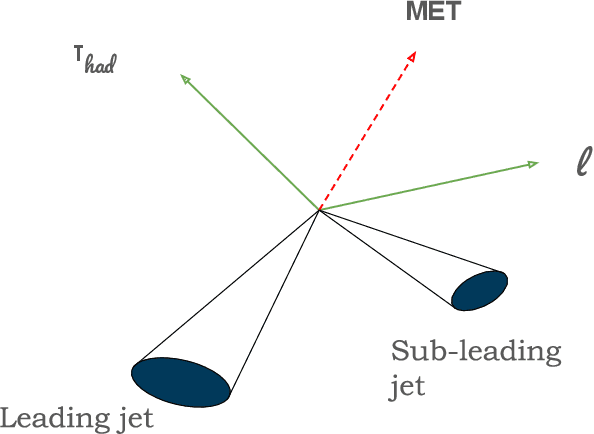
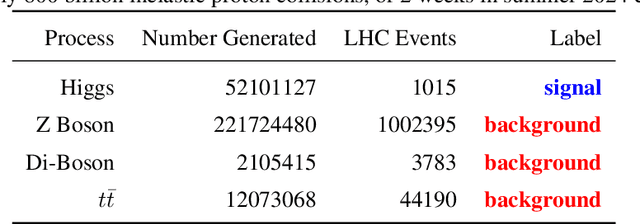
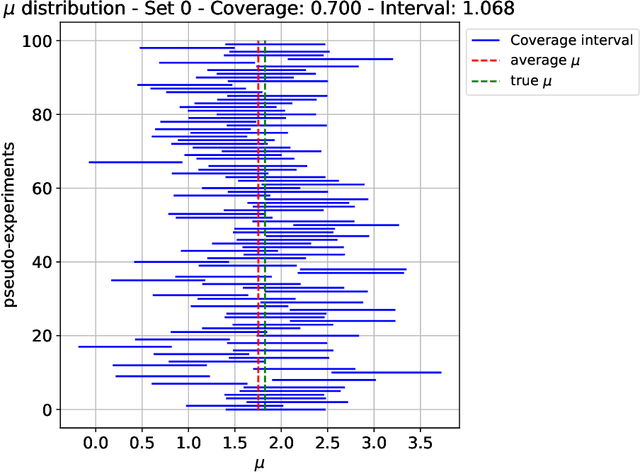
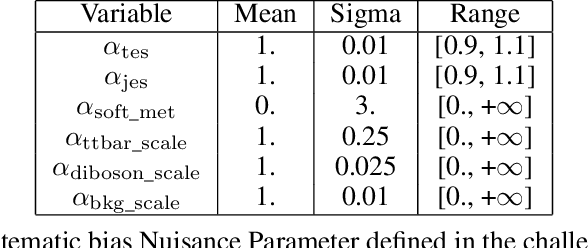
Abstract:The FAIR Universe -- HiggsML Uncertainty Challenge focuses on measuring the physics properties of elementary particles with imperfect simulators due to differences in modelling systematic errors. Additionally, the challenge is leveraging a large-compute-scale AI platform for sharing datasets, training models, and hosting machine learning competitions. Our challenge brings together the physics and machine learning communities to advance our understanding and methodologies in handling systematic (epistemic) uncertainties within AI techniques.
Towards Foundation Models for Scientific Machine Learning: Characterizing Scaling and Transfer Behavior
Jun 01, 2023



Abstract:Pre-trained machine learning (ML) models have shown great performance for a wide range of applications, in particular in natural language processing (NLP) and computer vision (CV). Here, we study how pre-training could be used for scientific machine learning (SciML) applications, specifically in the context of transfer learning. We study the transfer behavior of these models as (i) the pre-trained model size is scaled, (ii) the downstream training dataset size is scaled, (iii) the physics parameters are systematically pushed out of distribution, and (iv) how a single model pre-trained on a mixture of different physics problems can be adapted to various downstream applications. We find that-when fine-tuned appropriately-transfer learning can help reach desired accuracy levels with orders of magnitude fewer downstream examples (across different tasks that can even be out-of-distribution) than training from scratch, with consistent behavior across a wide range of downstream examples. We also find that fine-tuning these models yields more performance gains as model size increases, compared to training from scratch on new downstream tasks. These results hold for a broad range of PDE learning tasks. All in all, our results demonstrate the potential of the "pre-train and fine-tune" paradigm for SciML problems, demonstrating a path towards building SciML foundation models. We open-source our code for reproducibility.
Long-term stability and generalization of observationally-constrained stochastic data-driven models for geophysical turbulence
May 09, 2022



Abstract:Recent years have seen a surge in interest in building deep learning-based fully data-driven models for weather prediction. Such deep learning models if trained on observations can mitigate certain biases in current state-of-the-art weather models, some of which stem from inaccurate representation of subgrid-scale processes. However, these data-driven models, being over-parameterized, require a lot of training data which may not be available from reanalysis (observational data) products. Moreover, an accurate, noise-free, initial condition to start forecasting with a data-driven weather model is not available in realistic scenarios. Finally, deterministic data-driven forecasting models suffer from issues with long-term stability and unphysical climate drift, which makes these data-driven models unsuitable for computing climate statistics. Given these challenges, previous studies have tried to pre-train deep learning-based weather forecasting models on a large amount of imperfect long-term climate model simulations and then re-train them on available observational data. In this paper, we propose a convolutional variational autoencoder-based stochastic data-driven model that is pre-trained on an imperfect climate model simulation from a 2-layer quasi-geostrophic flow and re-trained, using transfer learning, on a small number of noisy observations from a perfect simulation. This re-trained model then performs stochastic forecasting with a noisy initial condition sampled from the perfect simulation. We show that our ensemble-based stochastic data-driven model outperforms a baseline deterministic encoder-decoder-based convolutional model in terms of short-term skills while remaining stable for long-term climate simulations yielding accurate climatology.
The use of Convolutional Neural Networks for signal-background classification in Particle Physics experiments
Feb 13, 2020

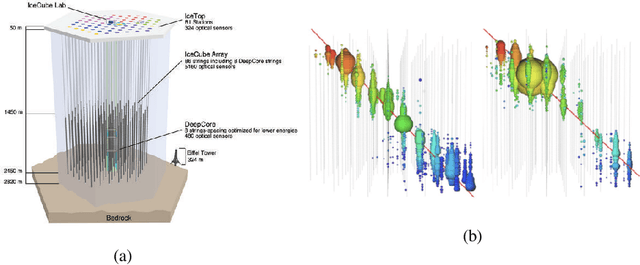

Abstract:The success of Convolutional Neural Networks (CNNs) in image classification has prompted efforts to study their use for classifying image data obtained in Particle Physics experiments. Here, we discuss our efforts to apply CNNs to 2D and 3D image data from particle physics experiments to classify signal from background. In this work we present an extensive convolutional neural architecture search, achieving high accuracy for signal/background discrimination for a HEP classification use-case based on simulated data from the Ice Cube neutrino observatory and an ATLAS-like detector. We demonstrate among other things that we can achieve the same accuracy as complex ResNet architectures with CNNs with less parameters, and present comparisons of computational requirements, training and inference times.
Etalumis: Bringing Probabilistic Programming to Scientific Simulators at Scale
Jul 08, 2019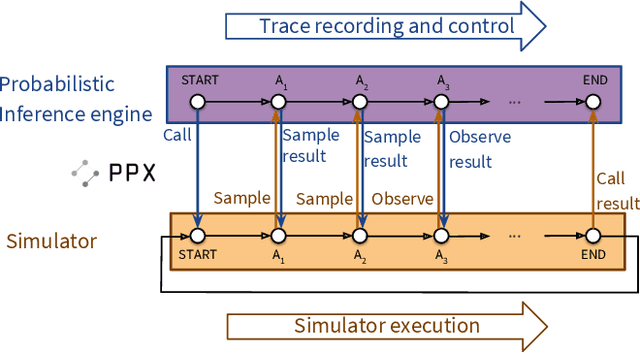

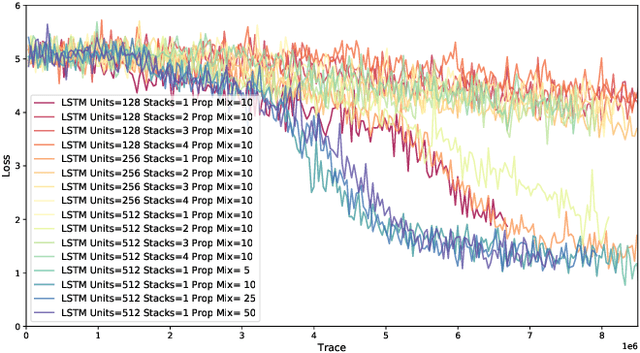
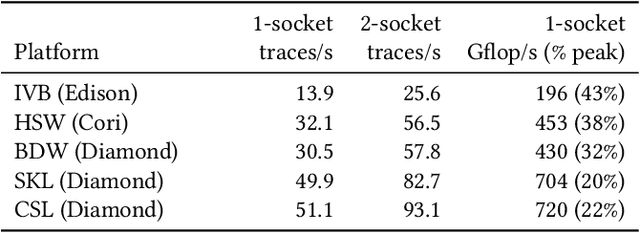
Abstract:Probabilistic programming languages (PPLs) are receiving widespread attention for performing Bayesian inference in complex generative models. However, applications to science remain limited because of the impracticability of rewriting complex scientific simulators in a PPL, the computational cost of inference, and the lack of scalable implementations. To address these, we present a novel PPL framework that couples directly to existing scientific simulators through a cross-platform probabilistic execution protocol and provides Markov chain Monte Carlo (MCMC) and deep-learning-based inference compilation (IC) engines for tractable inference. To guide IC inference, we perform distributed training of a dynamic 3DCNN--LSTM architecture with a PyTorch-MPI-based framework on 1,024 32-core CPU nodes of the Cori supercomputer with a global minibatch size of 128k: achieving a performance of 450 Tflop/s through enhancements to PyTorch. We demonstrate a Large Hadron Collider (LHC) use-case with the C++ Sherpa simulator and achieve the largest-scale posterior inference in a Turing-complete PPL.
Graph Neural Networks for IceCube Signal Classification
Sep 17, 2018
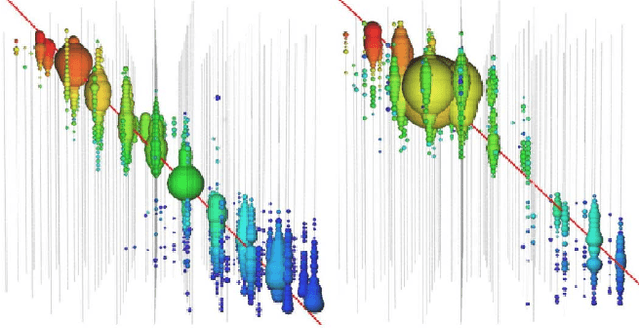


Abstract:Tasks involving the analysis of geometric (graph- and manifold-structured) data have recently gained prominence in the machine learning community, giving birth to a rapidly developing field of geometric deep learning. In this work, we leverage graph neural networks to improve signal detection in the IceCube neutrino observatory. The IceCube detector array is modeled as a graph, where vertices are sensors and edges are a learned function of the sensors' spatial coordinates. As only a subset of IceCube's sensors is active during a given observation, we note the adaptive nature of our GNN, wherein computation is restricted to the input signal support. We demonstrate the effectiveness of our GNN architecture on a task classifying IceCube events, where it outperforms both a traditional physics-based method as well as classical 3D convolution neural networks.
Efficient Probabilistic Inference in the Quest for Physics Beyond the Standard Model
Sep 01, 2018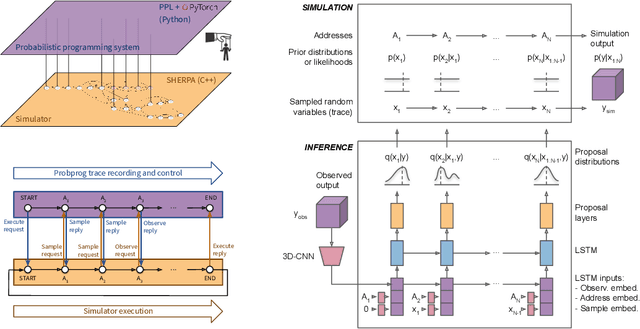
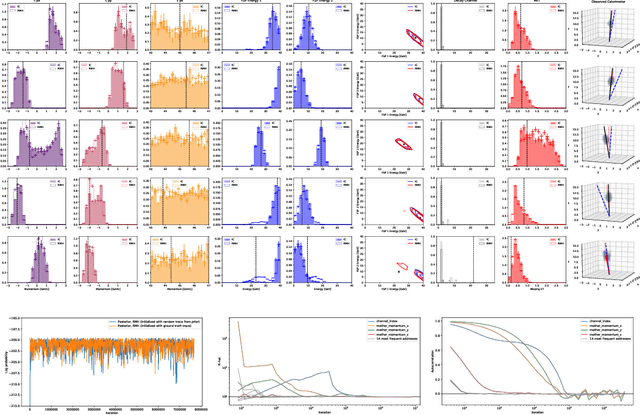

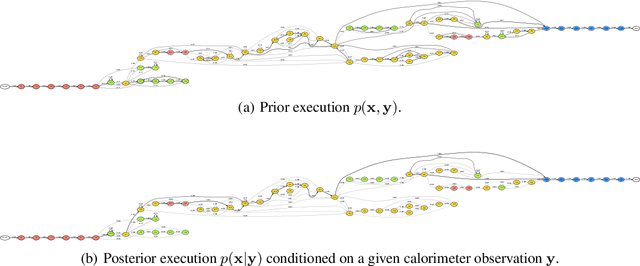
Abstract:We present a novel framework that enables efficient probabilistic inference in large-scale scientific models by allowing the execution of existing domain-specific simulators as probabilistic programs, resulting in highly interpretable posterior inference. Our framework is general purpose and scalable, and is based on a cross-platform probabilistic execution protocol through which an inference engine can control simulators in a language-agnostic way. We demonstrate the technique in particle physics, on a scientifically accurate simulation of the tau lepton decay, which is a key ingredient in establishing the properties of the Higgs boson. High-energy physics has a rich set of simulators based on quantum field theory and the interaction of particles in matter. We show how to use probabilistic programming to perform Bayesian inference in these existing simulator codebases directly, in particular conditioning on observable outputs from a simulated particle detector to directly produce an interpretable posterior distribution over decay pathways. Inference efficiency is achieved via inference compilation where a deep recurrent neural network is trained to parameterize proposal distributions and control the stochastic simulator in a sequential importance sampling scheme, at a fraction of the computational cost of Markov chain Monte Carlo sampling.
Creating Virtual Universes Using Generative Adversarial Networks
Aug 17, 2018
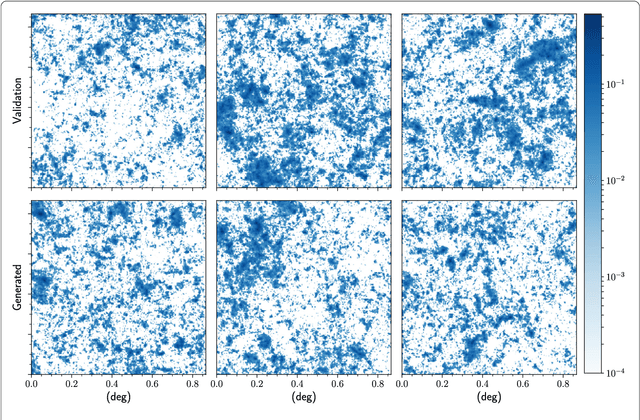

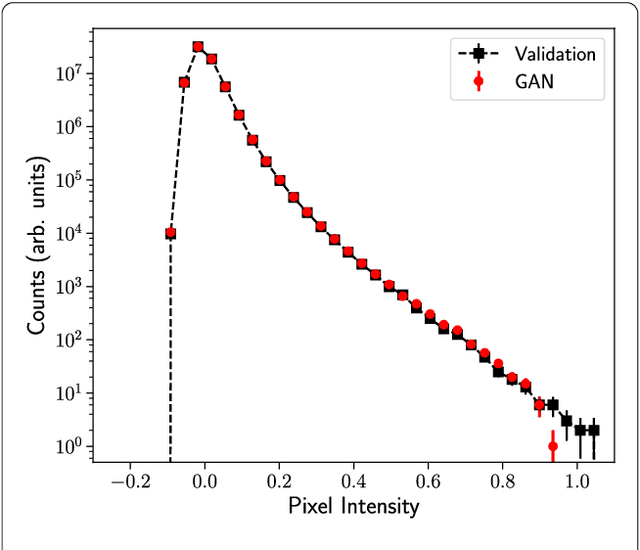
Abstract:Inferring model parameters from experimental data is a grand challenge in many sciences, including cosmology. This often relies critically on high fidelity numerical simulations, which are prohibitively computationally expensive. The application of deep learning techniques to generative modeling is renewing interest in using high dimensional density estimators as computationally inexpensive emulators of fully-fledged simulations. These generative models have the potential to make a dramatic shift in the field of scientific simulations, but for that shift to happen we need to study the performance of such generators in the precision regime needed for science applications. To this end, in this letter we apply Generative Adversarial Networks to the problem of generating cosmological weak lensing convergence maps. We show that our generator network produces maps that are described by, with high statistical confidence, the same summary statistics as the fully simulated maps.
 Add to Chrome
Add to Chrome Add to Firefox
Add to Firefox Add to Edge
Add to Edge